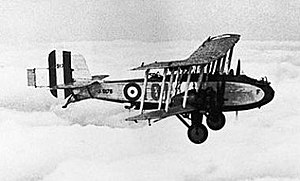Boulton & Paul Sidestrand
| Boulton Paul P. 29 Sidestrand | |
|---|---|

|
|
| Type: | bomber |
| Design country: | |
| Manufacturer: | |
| First flight: |
1926 |
| Commissioning: |
1928 |
| Number of pieces: |
20th |
The Boulton & Paul P. 29 Sidestrand was a twin-engine medium day bomber of the Royal Air Force . The biplane had its maiden flight in 1926. The machine was named after the town of Sidestrand in the North Norfolk District .
history
The two prototypes had the name Side beach MK I . These two machines and the six of the first production batch ( Sidestrand MK II ) that followed from 1928 were powered by Bristol Jupiter VI engines without propeller gears, the following nine Sidestrand MK III machines were fitted with squat Jupiter VIIIF engines. Last but not least, three MK II were produced.
Three machines of the MK III series were converted to the MK V configuration , this version was then renamed Overstrand . The Boulton & Paul P. 75 Overstrand replaced the Sidestrand from December 1934.
Construction and special features
The braced double-decker was constructed in metal from steel and light metal. It had an air-sprung and hydraulically damped tail wheel landing gear . The engines were mounted in small engine pods on the lower wing. Air-cooled nine-cylinder radial engines of the Bristol Jupiter type were used.
For the fuselage, steel tubes with light metal knot connectors were used. In it, the positions of the nose gunner, pilot and rear gunner were arranged one behind the other. This could either - depending on the position from which the attacker approached - fire from the top of the fuselage to the rear upwards or through an opening in the underside of the fuselage downwards at an angle. The cockpit and shooting range were open. In the fuselage there were three fuel tanks one behind the other with a total of 225 gallons (front 90 gal., Middle 65 gal., Rear 70 gal.), With the engines being supplied from the middle tank. An additional 35 gal. Of fuel could be carried for transfers with reduced payload.
The braced and braced wings were built in spar and rib construction. Ailerons were present in the upper and lower wings. The wings had a rectangular plan, the outer wings were swept back slightly from the motor nacelles. The spars consisted of a composite of rolled sheet steel profiles. The profile-giving wing ribs were also composed of various steel profiles. The wings were covered with fabric. As airfoil was "BP10" used a modified Zhukovsky profile.
Technical specifications
- Wingspan: 21.92 m
- Length: 14.02 m
- Height: 4.52 m
- Wing area: 91.04 m²
- Empty weight: 2726 kg
- Max. Takeoff weight: 4627 kg
- Service ceiling: 6315 m
- Range (with max. Load): 805 km
- Crew: 3
- Top speed: 225 km / h
- Landing speed: 76 km / h (82 km / h with stationary engines)
- Engines: two radial engines Bristol Jupiter VIIIF with 343 kW each
- Armament: two 7.7 mm Lewis machine guns in two arms
- Bomb load: 476 kg (max.)
swell
- "The Boulton & Paul Sidestrand I", Flight , edition of. March 29, 1928, page 206 ff. , Available online at flightglobal.com - Aviation History - PDF archive, in English - accessed on May 10, 2015
- Boulton-Paul P. 29 Sidestrand in the Virtual Aircraft Museum , accessed May 10, 2015
Individual evidence
- ↑ The Incomplete Guide to Airfoil Usage , page of the Applied Aerodynamics Group at the UIUC ( Memento of the original from April 20, 2010 in the Internet Archive ) Info: The archive link was inserted automatically and has not yet been checked. Please check the original and archive link according to the instructions and then remove this notice. , accessed on May 14, 2015